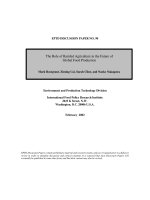The precautionary principle: protecting public health, the environment and the future of our children pptx
Bạn đang xem bản rút gọn của tài liệu. Xem và tải ngay bản đầy đủ của tài liệu tại đây (666.71 KB, 219 trang )
The precautionary principle:
protecting public health, the environment
and the future of our children
Edited by:
Marco Martuzzi and Joel A. Tickner
Keywords
RISK ASSESSMENT
RISK MANAGEMENT
UNIVERSAL PRECAUTIONS
CHILD WELFARE
ENVIRONMENTAL HEALTH
PUBLIC HEALTH
SUSTAINABILITY
ISBN 92 890 1098 3
Address requests about publications of the WHO Regional Office to:
x by e-mail
(for copies of publications)
(for permission to reproduce them)
(for permission to translate them)
x by post Publications
WHO Regional Office for Europe
Scherfigsvej 8
DK-2100 Copenhagen Ø, Denmark
© World Health Organization 2004
All rights reserved. The Regional Office for Europe of the World Health Organization
welcomes requests for permission to reproduce or translate its publications, in part or in
full.
The designations employed and the presentation of the material in this publication do not
imply the expression of any opinion whatsoever on the part of the World Health
Organization concerning the legal status of any country, territory, city or area or of its
authorities, or concerning the delimitation of its frontiers or boundaries. Where the
designation “country or area” appears in the headings of tables, it covers countries,
territories, cities, or areas. Dotted lines on maps represent approximate border lines for
which there may not yet be full agreement.
The mention of specific companies or of certain manufacturers’ products does not imply
that they are endorsed or recommended by the World Health Organization in preference to
others of a similar nature that are not mentioned. Errors and omissions excepted, the
names of proprietary products are distinguished by initial capital letters.
The World Health Organization does not warrant that the information contained in this
publication is complete and correct and shall not be liable for any damages incurred as a
result of its use. The views expressed by authors or editors do not necessarily represent the
decisions or the stated policy of the World Health Organization.
Contents
Contributors i
Acknowledgements iv
Foreword v
Executive summary 1
1. Introduction – the precautionary principle: protecting
public health, the environment and the futureof our
children 7
Marco Martuzzi & Joel Tickner
2. Dealing with uncertainty – how can the precautionary
principle help protect the future of our children? 15
WHO
3. The precautionary principle: a legal and policy history 31
Andrew Jordan & Timothy O’Riordan
4. Public health and the precautionary principle 49
Neil Pearce
5. Why is a precautionary approach needed? 63
Ted Schettler & Carolyn Raffensperger
6. The precautionary principle in decision-making:
the ethical values 85
Pietro Comba, Marco Martuzzi & Caterina Botti
7. Late lessons from early warnings: improving science and
governance under uncertainty and ignorance 93
David Gee & Andrew Stirling
8. Applying the precautionary principle in environmental
risk assessment to children 121
Philip J. Landrigan & Leonardo Trasande
9. The precautionary principle in environmental science 145
David Kriebel, Joel A. Tickner, Paul Epstein, John Lemons,
Richard Levins, Edward L. Loechler, Margaret Quinn,
Ruthann Rudel, Ted Schettler & Michael Stoto
10. The precautionary principle: a central and eastern
European perspective 167
Janos Zlinszky
11. Implementing precaution: assessment and application
tools for health and environmental decision-making 181
Andrew Stirling & Joel A. Tickner
12. A compass for health: rethinking precaution and its role
in science and public health 209
Joel A. Tickner, David Kriebel & Sara Wright
i
Contributors
Caterina Botti, Department of Philosophy and Social Sciences,
University of Siena, Siena, Italy
Pietro Comba, National Institute of Health, Rome, Italy
Paul Epstein, Center for Health and the Global Environment,
Harvard University Medical School, Boston, Massachusetts,
USA
David Gee, European Environment Agency, Copenhagen,
Denmark
Andrew Jordan, Centre for Social and Economic Research on
the Global Environment (CSERGE), University of East Anglia,
Norwich, England, United Kingdom
David Kriebel, Lowell Center for Sustainable Production,
Department of Work Environment, University of
Massachusetts Lowell, Lowell, Massachusetts, USA
Philip J. La
ndrigan, Department of Community and
Preventive Medicine, Department of Pediatrics, Mount Sinai
School of Medicine, New York, New York, USA
John Lemons, Department of Life Sciences, University of New
England, Biddeford, Maine, USA
Richard Levins, Department of Population and International
Health, Harvard University School of Public Health, Boston,
Massachusetts, USA
Edward L. Loechler, Department of Biology, Boston
University, Boston, Massachusetts, USA
Marco Martuzzi, WHO European Centre for Environment and
Health, Rome Operational Division, WHO Regional Office for
Europe, Rome, Italy
ii
Timothy O’Riordan, Centre for Social and Economic Research
on the Global Environment (CSERGE), University of East
Anglia, Norwich, England, United Kingdom
Neil Pearce, Centre for Public Health Research, Massey
University Wellington Campus, Wellington, New Zealand
Margaret Quinn, Department of Work Environment,
University of Massachusetts Lowell, Lowell, Massachusetts,
USA
Carolyn Raffensperger, Science and Environmental Health
Network, Ames, Iowa, USA
Ruthann Rudel, Silent Spring Institute, Newton,
Massachusetts, USA
Ted Schettler
, Science and Environmental Health Network,
Newburyport, Massachusetts, USA
Andrew Stirling, Science and Policy Research Unit, University
of Sussex, Sussex, England, United Kingdom
Michael Stoto, Department of Biostatistics, George
Washington University School of Medicine, Washington,
District of Columbia, USA
Joel Tickner, Lowell Center for Sustainable Production,
Department of Work Environment, University of
Massachusetts Lowell, Lowell, USA
Leonardo Trasande, Center for Children’s Health and the
Environment, Department of Community and Preventive
Medicine, Department of Pediatrics, Mount Sinai School of
Medicine, New York, New York, USA
iii
Sara Wright, Lowell Center for Sustainable Production,
University of Massachusetts Lowell, Lowell, Massachusetts,
USA
Janos Zlinsky, Regional Environmental Center for Central
and Eastern Europe, Budapest, Hungary
iv
Acknowledgements
This publication was conceived and assembled during the
preparation of the Fourth Ministerial Conference on
Environment and Health, Budapest, Hungary, 23–25 June
2004. Discussion and negotiation on the theme of the
precautionary principle was highly stimulating and provided
invaluable intellectual contribution for the development of the
monograph.
We thank David Breuer for editing the text, Rachel Massey for
initially revising the text, Maria Teresa Marchetti for
organizing the publication process and design and Francesco
Mitis for typesetting.
We are grateful to Island Press, the National Institute of
Environmental Health Sciences and Oxford University Press
for granting permission to reproduce Chapters 7, 9 and 12
respectively.
v
Foreword
Human society has been developing rapidly. In Europe and
elsewhere, industrial, technological and economic development
has created wealth and opportunity. Health has largely
benefited: many people in Europe, although unfortunately not
all, live longer and better than ever before. These positive
trends must be sustained and extended to as many people as
possible.
Technological development has often outpaced scientific
knowledge related to the determinants of health. Increasing
complexity in societal organization multiplies the pathways by
which a variety of agents can affect health, including physical
risk factors such as toxic chemicals or radiation, social
circumstances such as exclusion and deprivation, limited
access to clean natural resources, and the endless
combinations of them all. Decisions taken in domains
apparently distant from health often have the potential to
affect people’s health positively or negatively because of the
great number of connections and exchanges in modern life.
Health is a function of highly complex systems, which can be
unintentionally disrupted in unpredictable ways and result in
adverse health consequences that may be serious and
irreversible.
When solid science is available, health can be protected
effectively through preventive action. However, people must
humbly acknowledge that science has limitations in dealing
with the complexity of the real world and do their utmost to
promote the development and progress of science. While
people strive for better science, how can health be protected?
In particular, how can people ensure that children and future
generations will have the opportunity that many people have
of reaping the benefits of progress and enjoying good health?
This question is difficult. Irreparable mistakes must be
avoided, such as those related to tobacco or asbestos, when
people waited for definitive evidence far too long before
springing to action. Further, irremediable chains of events
leading to health damage must be prevented from being
triggered.
vi
Precaution has been at the heart of public health protection
for centuries, and the precautionary principle is indeed related
to acting under uncertainty, an increasingly common
circumstance in these days. The precautionary principle has
been gaining prominence and profile and has become a guiding
principle in modern thinking in environment and health – a
most welcome development for WHO and everyone engaged in
public health. If used intelligently, imaginatively and
daringly, the precautionary principle will support efforts to
strive towards a healthier and safer world. I am glad to
present a book that, we hope, will bring the debate forward.
Roberto Bertollini
Director, Division of Technical Support, Health Determinants
WHO Regional Office for Europe
1
Executive summary
The purpose of this document is to provide a background
rationale and support to WHO’s working document “Dealing
with uncertainty: how can the precautionary principle help
protect the future of our children?”, prepared for the Fourth
Ministerial Conference on Environment and Health held in
Budapest, Hungary, in June 2004.
Technological developments have provided important benefits
to health and the environment. Energy provision, waste and
water treatment systems, modern housing, transport, modern
food production and distribution systems, immunization, pest
control and telecommunications have played important roles
in improving health and the quality of life while increasing life
expectancy and protecting the environment. Nevertheless,
societal change and rapid technological development over the
last century have also produced an increasing variety of
agents and circumstances whose consequences are partly
unknown, are difficult to predict, and capable of posing
irreversible risks to human health and that of the ecosystem.
While our understanding of environmental and health risks
has advanced greatly, so has the complexity of the factors that
can affect health. Thus, large uncertainties remain of the
effects on health of many activities. Of particular concern are
the health and environmental impacts of technologies that can
affect future generations. A key question is how human
societies can continue to obtain the great benefits of
development while promoting a clean and healthy
environment and ensuring an adequate standard of living in
the future.
As the nature of threats to health and the environment
becomes more complex, uncertain and global in nature, the
precautionary principle is increasingly being debated. The
principle states that in the case of serious or irreversible
threats to the health of humans or the ecosystem,
acknowledged scientific uncertainty should not be used as a
reason to postpone preventive measures.
2
Debate about the precautionary principle is partly a response
to the recognition of the severe social and economic costs of not
taking precautions. Millions of children worldwide have
suffered from neurological damage, diminished mental
capacity and thus the ability to make a living as a result of
exposure to lead from smelters, in paint and in petrol.
Tobacco, asbestos and numerous other agents provide ample
evidence of the high costs associated with waiting for
convincing proof of harm. These cases exemplify the failure of
science and policy to prevent damage to health and ecosystems
and the resulting impacts on health and the economy.
In line with the mandate given by the Third Ministerial
Conference on Environment and Health, WHO has developed
an approach that will promote preventive public health
measures in areas of emerging concern about environmental
impacts on children’s health. The approach focuses on how the
precautionary principle can be applied to the protection of
children’s health and that of future generations. In so doing,
the goal of WHO is to guide and improve decision-making in
environment and health under conditions of uncertainty and
complexity, while stimulating scientific development and more
sustainable forms of economic development. The approach is
sufficiently flexible to be applied by all countries in the WHO
European Region, regardless of their available resources.
Through articles written by leading public and environmental
health scientists, this document outlines a scientific, ethical
and public health approach to applying the precautionary
principle to protect children and future generations. The
report also presents scientific tools for characterizing
uncertain and complex risks, linking these with tools for
cleaner production and innovation in safer technologies and
activities. It builds on the analyses and discussions convened
by the World Health Organization and the European
Environment Agency, among others, concerning lessons
learned from not taking precaution and best practices for
decision-making under uncertainty, and on intensive
discussion with Member States in the preparation of the
Fourth Ministerial Conference on Environment and Health.
3
The findings of the report include the following.
x The concepts of precaution and prevention have
always been at the heart of public health practice.
Public health is inherently about identifying and
avoiding risks to the health of populations, as well as
about identifying and implementing protective
measures. In the past, public health interventions
focused on removing hazards that had already been
identified and “proven” (even if the etiological
mechanisms were not well understood). As “modern”
potential risk factors become more complex and far-
reaching, the precautionary principle addresses
uncertain risks and seeks to shift the ways in which
science informs policy from a strategy of “reaction” to a
strategy of “precaution”. Together with related
approaches such as health impact assessment,
precaution provides a useful means of guiding public
health decisions under conditions of uncertainty, in a
manner that appropriately addresses the issues of
power, ownership, equity and dignity.
x The precautionary principle encourages policy-makers
and public health professionals to consider, in their
approach to public health, how to account for growing
complexity and uncertainty. Substantial evidence
supports the conclusion that contemporary
environmental health risks result from complex
interactions among genetic, nutritional, environmental
and socioeconomic factors. The precautionary principle
can be used to encourage research, innovation and
cross-disciplinary problem-solving in the face of these
complex risks. It serves as a guide for considering the
effects of human activities and provides a framework
for protecting humans, other species and life-
sustaining ecological systems now and in the future.
x The precautionary principle is occasionally portrayed
as contradicting the tenets of sound science and as
being inconsistent with the norms of “evidence-based”
decision-making. These criticisms might be based on
4
effective misuse of the precautionary principle, but it
is nevertheless important to clarify the role of
environmental science in policy-making.
x Many pressing environmental crises share a
fundamental characteristic: they appear to arise from
disruptions of natural systems or cycles, the behaviour
of which is only partially understood. Two conclusions
may be drawn. First, there is a great need for more
scientific research to fill the gaps in our knowledge.
Second, while waiting for a more complete
understanding we must find ways to make decisions
that are based on the best available evidence, while
acknowledging the uncertainties that remain. Thus,
there is no contradiction between pursuing scientific
progress and taking precautionary action. Indeed,
applying precaution demands more rigorous science in
order to characterize complex risks, clarify gaps in
knowledge and identify early warnings and
unintended consequences of actions. It also means
using science not only for the diagnosis of
environmental hazards but to identify, develop and
assess safer alternatives to potentially harmful
activities.
x Countries whose economies are in transition have
special environment and health problems. The
consequences of past pollution, economic hardship,
poor or even deteriorating public health and the
demands of rapid political, social and economic change
pose additional problems for decision-makers. In such
countries economic priorities may outweigh the need to
protecting health. The precautionary principle is thus
very important here, because it can inform decisions
under the great uncertainty that prevails, can help
build public confidence, can raise research and
innovation capacities, can ensure that mistakes made
in the past in industrialized countries are not
repeated, and can help shift burdens from the public
institutions to those creating the risks.
5
x There is no single recipe for applying precaution.
Applying precaution should encourage decision-
makers to use the broadest possible range of
information, including stakeholders’ views, and to
examine alternative courses of action. Flexibility in
applying precaution is critically important, since each
decision is different – with different types of risk,
evidence, uncertainty, affected communities,
availability of alternatives, and technical and financial
resources. Consistency thus comes from using the
same precautionary framework and process in each
case. What is considered an “acceptable risk” or
sufficient evidence to act is a function not only of the
level of risk and the strength of evidence and
uncertainty, but also of the magnitude, reversibility
and distribution of the risk, the availability of
opportunities to prevent risk, the public’s risk
aversion, society’s culture and values, and the pros
and cons of alternative options.
x These preventive precautionary actions ultimately aim
at continuously reducing and if possible removing
exposures to potentially harmful substances, activities
and other conditions. If progress is to be made in this
direction, one should:
- encourage the replacement of dangerous
substances and activities with less dangerous
substances or technologies where suitable
alternatives are available;
- reconsider production processes, products and
human activities so as to minimize significant
adverse effects on health and the environment,
for example through the use of integrated pest
management strategies, land use planning and
cleaner production;
6
- establish public health goals for protecting the
health of humans and ecosystems (such as for
reducing blood lead levels or improving
fisheries);
- provide information and education to the
public to promote empowerment and
accountability;
- integrate precautionary considerations into the
research agenda to facilitate rapid
interventions to prevent damage to health; and
- minimize, so far as possible, unintended
adverse consequences that may be caused by
precautionary actions.
The debate around the precautionary principle has provided
many insights relevant to improving public health decision-
making under conditions of uncertainty. It is hoped that this
document will provide an additional basis for approaches to
attaining the concurrent goals of (a) protecting adults,
children and future generations and the ecosystems on which
we depend and (b) enhancing economic development,
sustainability and innovation in science, research and policy.
7
1. Introduction – the precautionary principle:
protecting public health, the environment and
the future of our children
Marco Martuzzi & Joel Tickner
Technological development has provided important benefits
for health and the environment. Energy supply, water and
waste-treatment systems, modern housing, transport, modern
food production and distribution systems, immunization, pest
control and telecommunication have played important roles in
improving health and the quality of life while increasing life
expectancy and protecting the environment. In parallel,
changing societies and rapid technological development over
the 20th century have produced an ever-increasing variety of
agents and circumstances whose consequences are partly
unknown, difficult to predict and capable of posing irreversible
risks to human and ecosystem health. Although
understanding of environmental and health risks has
advanced greatly, so has the complexity of the factors that can
affect health. Thus, great uncertainty remains about the
health effects of many activities. Of particular concern are the
health and environmental effects of technologies that can
affect future generations and their ability to achieve
sustainable development. A key question is how people can
continue to obtain the great societal benefits of development
while promoting a clean and healthy environment into the
future. Reconciling the need to innovate and develop with the
need to protect human health from environmental risks is
therefore essential.
The precautionary principle states that, in cases of serious or
irreversible threats to the health of humans or ecosystems,
acknowledged scientific uncertainty should not be used as a
reason to postpone preventive measures. The principle
originated as a tool to bridge uncertain scientific information
and a political responsibility to act to prevent damage to
Martuzzi & Tickner
8
human health and to ecosystems. The debate around the
precautionary principle is important and challenging, as it
involves fundamental dimensions of human life, such as the
right to health and to a clean environment and the aspiration
for better standards of living. When such elements are
potentially in conflict, such as when precautionary action
might disrupt the free flow of trade, policy development often
becomes controversial.
The quality and relevance of available scientific information is
central to the debate. Currently available methods for
evaluating the risks to human health and ecosystems, mostly
designed to deal with direct associations between exposure
and disease, are often not sufficient for effectively
characterizing complex environmental risks. Limitations in
scientific tools and in the ability to identify or to quantify
causal relationships are occasionally misinterpreted as
evidence of safety. Thus, when proposed or ongoing
technologies or activities entail potential long-term, unknown
adverse health effects, the need for more accurate scientific
information has often been used as a reason for inaction.
Further, government agencies frequently have to wait until
sufficient evidence of harm is established beyond a reasonable
doubt before they can act to prevent harm. This constraint can
result in public health and environmental policies based on
reaction, involving remedial action after a hazard has caused
adverse effects, rather than preventive, precautionary action.
The increasing complexity and uncertainty of risks and the
frequent lack of information on risks as well as the limits of
science and policy structures to adequately address them
require the development of tools to further support decision-
making when health and welfare might be affected.
Failure to take precautionary action can have severe social
and economic costs. Millions of children worldwide have
suffered from nervous system damage, diminished mental
capacity and thus ability to make a living, as a result of
exposure to lead from smelters, in paint and in gasoline.
Tobacco, asbestos and numerous other agents provide ample
evidence of the high costs associated with waiting for
convincing proof of harm. These cases exemplify the failures of
1. Introduction
9
science and policy to prevent damage to health and ecosystems
and the resulting effects on health and the economy.
This report
In recent years, significant advances have been made in
interpreting and implementing the precautionary principle
and in developing effective scientific and policy structures to
address complex and uncertain risks. However, little attention
has been paid to how precaution can be applied to protecting
children’s health or across countries and regions with differing
technical and economic capacity.
This report provides a background rationale, additional
reference and support to the 2003 WHO working
document
Dealing with uncertainty: how can the precautionary
principle help protect the future of our children?
(Chapter 2 of
this publication). The WHO working document, as well as this
publication, were prepared for the Fourth Ministerial
Conference on Environment and Health in June 2004 in
Budapest, Hungary. In accordance with the mandate given by
the Third Ministerial Conference on Environment and Health
in 1999, the WHO Regional Office for Europe has investigated
tools and processes to promote protective public health
measures in areas of emerging concern about environmental
effects on children’s health. The approach focuses on how the
precautionary principle can be applied to protecting the health
of children and that of future generations. WHO’s goal in this
undertaking is to guide and improve decision-making in
environment and health in order to protect children and future
generations under conditions of uncertainty and complexity
while stimulating scientific progress and more sustainable
forms of development. The approach is sufficiently flexible to
be applied by all countries in the European Region, regardless
of the resources available.
Through chapters written by leading public health and
environmental health scientists, this report outlines a
scientific, ethical and public health rationale for applying the
precautionary principle to protect children and future
generations. The report also presents scientific tools and
processes for characterizing uncertain and complex risks,
Martuzzi & Tickner
10
linking these with tools for cleaner production and innovation
in safer technologies and activities.
The first part of the report (Chapters 3–6) explores the
foundations; the second part (Chapters 7–12) underlines the
relevance of the precautionary principle with regard to
priorities in environment and health and addresses its
implementation.
Andrew Jordan and Timothy O’Riordan present a historical
perspective on the precautionary principle. Jordan and
O’Riordan note that, although the principle originated in the
social planning principle in Germany,
Vorsorgeprinzip
, the
form in which it has been adopted in various countries and
international agreements, has necessarily varied based on the
political, economic and legal aspects of each jurisdiction. They
note that the history of the precautionary principle shows a
steady shift towards more internationalized environmental
decision-making and the penetration of environmental and
health principles into non-environmental policy sectors such
as trade, industry and energy production. They outline the
core historical components of the precautionary principle and
note that some of these have been lost in current risk-based
environmental policy debates.
Neil Pearce outlines a public health rationale for precaution.
He argues that the concepts of precaution and prevention have
always been at the heart of public health practice. Public
health inherently means identifying and avoiding risks to the
health of populations as well as identifying and implementing
protective interventions. Pearce notes that, together with
related approaches such as health impact assessment,
precaution provides a useful compass to guide public health
decisions under uncertainty, in a manner that appropriately
addresses issues of power, ownership and, ultimately,
protection of health.
Ted Schettler and Carolyn Raffensperger provide a rationale
of why the precautionary principle is needed in addressing
complex, uncertain environment and health risks, including
the mounting evidence of the effects of human activities on
1. Introduction
11
ecosystems and health, the complexity of contemporary
environmental health risks and their uncertainty and the
limitations of current risk-based decision-making tools in
preventing complex risks. They note that the precautionary
principle encourages policy-makers and public health
professionals alike to consider how to account for growing
complexity and uncertainty in their approach to public health.
Pietro Comba, Marco Martuzzi and Caterina Botti address the
connections between the precautionary principle and the
underlying ethical values. They argue that, since
precautionary decision-making normally takes into account
questions of the distribution of exposure, vulnerable subgroups
and environmental justice in general, making explicit the
choice of value systems used is important. In particular, when
a utilitarian approach based on maximizing an average
welfare measure is not appropriate, Comba et al. propose an
alternative approach aimed at preventing the worst possible
consequences of any action. Such a principle, the “maximin”
principle, is thus highly consonant with the precautionary
principle.
David Gee and Andy Stirling analyse the lessons learned from
failure to take precautionary action based on early warnings
on a variety of ecosystem and health risks. Based on broad
discussions and research undertaken in the publication of the
European Environment Agency’s
Late lessons from early
warnings
, Gee and Stirling outline tools and strategies to
improve application of the precautionary principle and
preventive decision-making in the face of uncertain and
complex risks.
Philip J. Landrigan and Leonardo Trasande present a
rationale for the importance of applying the precautionary
principle to the protection of children and future generations.
They note that the rising incidence of preventable
environmentally related chronic diseases among children has
increased the urgency of applying the precautionary principle.
They outline the weaknesses of traditional risk assessment
approaches in capturing the often greater exposure and
susceptibility of children to environmental risks. They
Martuzzi & Tickner
12
conclude that the epidemic of lead poisoning among children
may pale in comparison to the environmental epidemics of the
future if governments do not prudently apply the
precautionary principle to protect the world’s richest resource
– our children.
David Kriebel and colleagues argue that application of the
precautionary principle can lead to sound application of
scientific knowledge and innovations in scientific method.
They note that, although the precautionary principle is
occasionally portrayed as contradicting the tenets of sound
science and being inconsistent with the norms of evidence-
based decision-making, these critiques are often based on a
misunderstanding of science and the precautionary principle.
Kriebel et al. note several ways in which current practice can
work against precautionary decision-making by narrowly
defining hypotheses or failing to address problems from an
interdisciplinary perspective. They outline ways in which
scientific research can be more supportive of acting in the face
of uncertain and complex risks. They conclude that a shift to
more precautionary policies creates opportunities and
challenges for scientists to think differently about the ways
they conduct studies and communicate results.
Janos Zlinsky outlines a central and eastern European
perspective on the precautionary principle. He notes the
unique vulnerability of countries in transition with stresses on
sensitive ecosystems, the effects of past pollution, public
health problems and demands for rapid political, social and
economic change, excessively stretched environment and
health authorities and economic hardship such as foreign debt.
All these factors increase uncertainty in decision-making.
Zlinsky concludes that the precautionary principle is
especially important in countries in transition because it can
allow decisions under the great uncertainty that exists, can
help build public confidence, can raise research and innovation
capacities and can shift burdens from the state to those
creating risks.
Andrew Stirling and Joel Tickner outline assessment schemes
for implementing precaution in practice. They discuss
1. Introduction
13
decision-making tools and criteria for improving health-
protective decision-making in the face of uncertainty and
complexity. They also present tools to implement
precautionary decisions to protect children and future
generations and to achieve sustainable development. Further,
they explore the notion of alternatives assessment, materials
policy, health impact assessment and public health goal
setting. They argue that a centerpiece of any approach to
precaution and sustainable development has to be seeking
safer alternatives to potentially harmful activities and agents.
Finally, Joel Tickner, David Kriebel and Sara Wright address
how three common criticisms of the precautionary principle
arise from misunderstandings of the relationship between
precautionary policy and science. These misunderstandings
include the notion that precaution stifles innovation, causes
unintended consequences potentially more serious than the
problem that triggered the precautionary action in the first
place and creates false-positives – apparent risks that waste
resources and distract from real problems. In responding to
these critiques, Tickner et al. note that society has not yet
realized the full potential of science-based policy to prevent
damage to ecosystems and health while ensuring progress
towards a healthier and economically sustainable future. They
conclude that interest in precaution provides an opportunity to
move towards a more constructive view of environment and
health policy, reinvigorating the core values and preventive
traditions of public health.
Conclusion: the way forward
The ultimate goals of public health and precaution are to
prevent disease, degradation and threats to human health and
ecosystems in addition to restoring conditions that foster
health. Although human activities cannot be risk-free,
precaution can stimulate more health-protective decision-
making under uncertainty and complexity. Debates over risks
are intrinsically complex, and precaution is not necessarily a
recipe for easy solutions. Further, environment and health
decisions are inevitably political in nature, value-laden and
affect economic interests, and tensions will always exist
between economic interests and other values. Precaution can
Martuzzi & Tickner
14
help to more systematically and broadly clarify risks,
uncertainty and alternatives. Although the concept of
precaution brings this to the forefront, decisions should always
be informed by the best available science, common sense and
community values.
Much work has been done to clarify the role of precaution in
environment and health decision-making and the theoretical
bases of the precautionary principle. This report attempts to
expand on discussions surrounding precaution to date, to
situate these discussions in the context of children’s health
and sustainable development and to provide assessment and
policy tools for applying precaution in practice. There is no
single checklist or strict guidelines on whether and how the
precautionary principle should be applied across decisions or
for a given circumstance. More important is focusing on a
common goal of adaptable tools for protecting and improving
health while stimulating innovation in safer and cleaner
production systems and human endeavours. The heuristic
considerations provided in the WHO paper provide some
general indications on the application of the precautionary
principle that are broadly useful for different types of
environmental risks.
The debate around the precautionary principle has provided
many insights relevant to improving public health decision-
making under uncertainty. We hope that this publication will
provide additional foundations for approaches that achieve the
concurrent goals of protecting children and future generations,
as well as adults and the ecosystems on which humans
depend, while enhancing economic development, sustainability
and innovation in science, research and policy.
15
e
2. Dealing with uncertainty – how can the
precautionary principle help protect the future
of our children?
Working document (EUR/04/5046267/11, 28 April 2004)
prepared by WHO Secretariat for the Fourth Ministerial Conference on
Environment and Health, Budapest, June 2004
“We will develop initiatives in our countries to give
greater emphasis in all relevant programmes to the need
to prevent the exposure of children to environmental
threats … We request the European Environment and
H alth Committee to identify methods and mechanisms
to: promote and encourage public health measures in
areas of emerging concern about environmental impacts
on children’s health, on the basis of the precautionary
principle.”
London Declaration on Action in Partnership (paragraph
50d), adopted at the Third Ministerial Conference on
Environment and Health (London, 16-18 June 1999)
Introduction
1. The precautionary principle has arisen as part of the
discussions on the most effective ways to protect health and the
environment in the face of highly uncertain risks. Since at least
the early 1980s, European policy-making on issues of
considerable concern and acknowledged scientific uncertainty
has progressively adopted precautionary approaches, in order to
achieve high levels of public health, environmental protection
and consumer safety without compromising science or
technological innovation. The European Commission’s
communication on the precautionary principle of February 2000
(Commission of the European Communities) was a first and
critical step in describing the purpose and use of the









